|
Gilbert Murray MP's Westminster Blog Gypping in the Marsh in Times Past A Brief History of Gypping in the Marsh Gypping in the Marsh - the Murray Connection Dates in the Gypping in the Marsh Village Calendar Saint Bodkin and his Holy Well Abigail Morris: Britain's Last Anchoress Famous Gypping in the Marsh Artists Gypping in the Marsh Local Businesses |
Gypping in the Marsh in Times PastThis webpage shows images of Gypping in the Marsh in times past, from the early days of photography up to the early 21st century. If you have any old photographs of Gypping in the Marsh that you would like to appear on this page, please email them to the Gypping in the Marsh village website webmaster. Young girl scavenging for scraps, Watery Lane, circa 1870This undated photograph of around 1870 shows a young girl scavenging for scraps among the heaps of refuse that fill Watery Lane. Watery Lane, now a road of desirable - if somewhat damp - residences, was regarded as being the poorer end of Gypping in the Marsh in Victorian times. With schooling not yet being compulsory for children and the invention of TikTok still being a century and a half away, scavenging for scraps was a popular way for many village children to spend their time in the 1870s. Interestingly, recent council cuts to the street cleaning budget have resulted in Watery Lane - and other roads in the village - regaining a little of their Victorian look and feel. 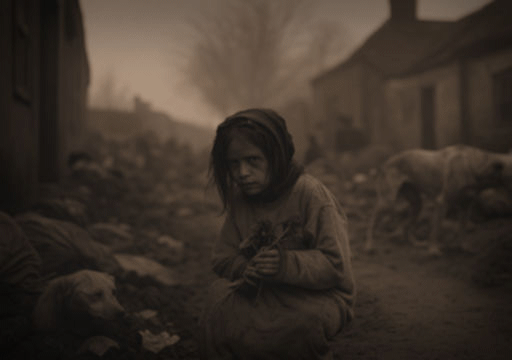 Murray's Adult Shop, Scrote Street, circa 1880This undated photograph shows Murray's Adult Shop, which once stood on the corner of Scrote Street and High Street. Bucking the general prudishness of the Victorian era, Murray's Adult Shop was unique in the Lincolnshire fens, being the only shop for miles around to sell adult-oriented goods and literature. The penny-farthing dates this photograph to around 1880; it was certainly taken before 1887, when Murray's Adult Shop was burned to the ground by a mob of protesting Methodists, following an ill-fated decision by Mr Murray to stock the now infamous Readers' Wives' Ankles illustrated pamphlet. Gypping Building Society now stands on the site. 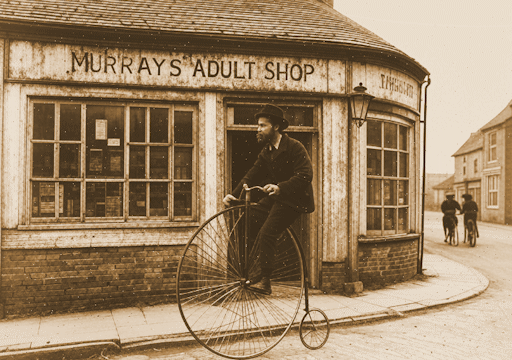 Obediah Murray's arsenic factory, circa 1880This undated photograph shows Obediah Murray's arsenic factory, a rare example of Victorian industry in the fens and Gypping in the Marsh's main employer in the late 1800s. Arsenic had an incredibly wide variety of applications in Victorian times, including face creams, foods, textiles, wallpapers and rat poison, and Murray's was the leading producer of arsenic in the east of England. After the dangers of arsenic became widely-known, Murray converted the factory to the production of mercury in 1893. Mercury was produced there until 1966, when the factory finally closed. After lying derelict for nearly three decades, the factory was finally demolished and the site cleared in 1994. The local council purchased the site for a knock-down price the following year, spread a layer of topsoil over the ground and gave it over to the communal allotments that can still be seen there today. 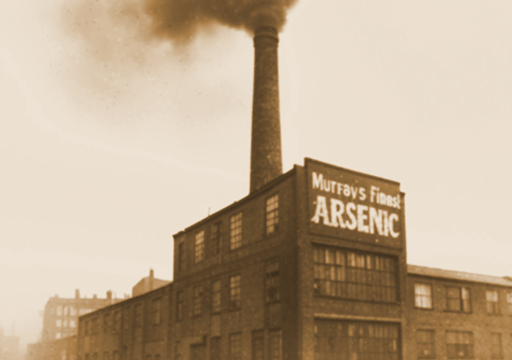 The Feast Day of Saint Bartholomew, 1882 and 1983Saint Bartholomew was famously martyred by having the skin flayed from his body - a particularly horrific death. He has been venerated by the villagers of Gypping in the Marsh for many centuries. On the Sunday closest to Saint Bartholomew's feast day, which lies on August 24th, the villagers take part in a unique ceremony. The women of Gypping in the Marsh line the village streets, holding scythes, rakes and other agricultural tools, which have been freshly sharpened in the weeks leading up to the day. One village man has the honour of being 'Bartholomew' for the day. As the village looks on, 'Bartholomew', naked apart from a scanty loincloth, runs through the roads in the village, attempting to avoid the women who are lining the streets, as they do their best to cut him with the tools they are wielding. The ceremony ends either when 'Bartholomew' reaches the safety of Saint Bodkin's churchyard, or when the village women manage to prevent him from doing so - whichever comes first. The following pictures show two instances of this ceremony taking place, over a hundred years apart: in 1882 and 1983. 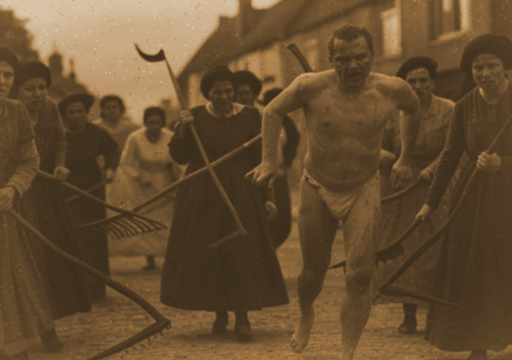 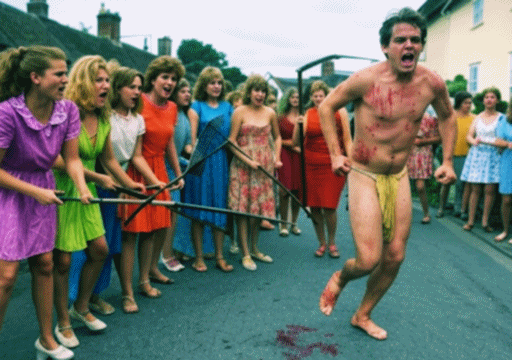 Records show that in 1882, 'Bartholomew' made it to the safety of the churchyard; his 1983 counterpart was not so lucky. Jeremiah Murray's cheesemonger's shop and dairy, late 1880sThese photographs, taken at some point in the late 1880s, show Jeremiah Murray in his cheesemonger's shop and his wife Sarah at work in their somewhat unconventional dairy. While most cheese in Britain is made from cow, sheep or goat milk, Murray, a keen dog breeder, came up with the ingenious idea of using milk from his great dane bitches to produce cheese. After a period of experimentation, he perfected his recipe and opened a cheesemonger's shop in Gypping in the Marsh High Street in 1887. 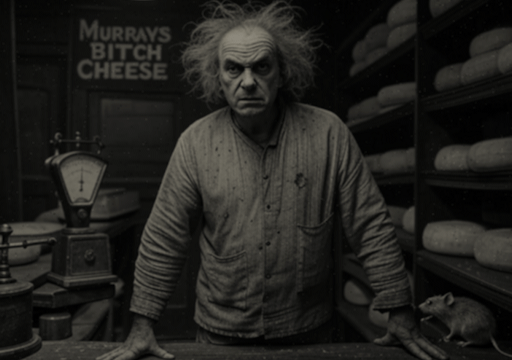 The sheer novelty of Murray's Bitch Cheese (as Murray marketed it) gave the shop an initial boost of popularity, with people travelling from all over Lincolnshire, and from even further afield, to visit the shop. However, once customers had tried the cheese, they tended not to come back to buy more. One report from 1887 noted that the cheese was 'overwhelmingly strong, bordering on rancid, with an unmistakable aroma and aftertaste of damp dog'. Faced with disappointing sales, Murray attempted to diversify, producing a blue-veined version of his cheese which he called 'Great Danish Blue'. However, the taste of this blue cheese turned out to be even more objectionable than the standard version, and a combination of poor sales and hygiene concerns forced Murray to close his shop in November 1889. 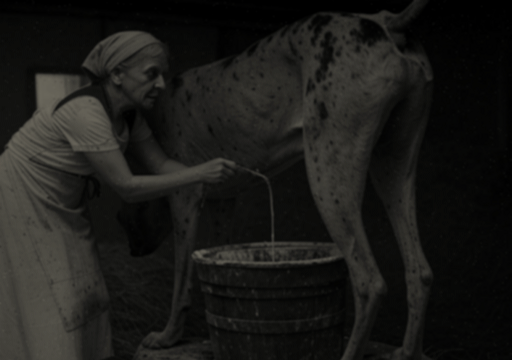 Saint Bunty's Orphanage, circa 1890These undated photographs show Saint Bunty's Orphanage (now Saint Bunty's Home for Parentally-Challenged Children) as it looked during the Victorian period. While the exterior of the building has changed quite radically since these photographs were taken - the new Duke of York dormitory wing now adjoins the right-hand side of the building as it appears in this shot - the photograph of the orphans inside one of the building's original dormitories looks as if it could have been taken yesterday. 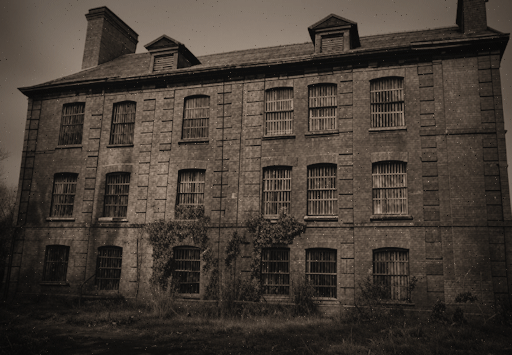 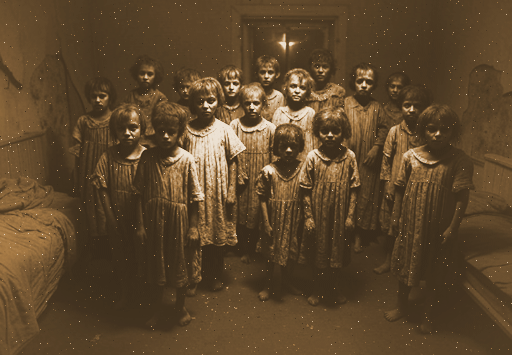 The Great Hall, Hemlock Hall, in its Victorian heydayThis undated photograph shows the Great Hall of Hemlock Hall during the Victorian era, when it was at the peak of its splendour. Since this photograph was taken, time has not been kind to Hemlock Hall, but its current owner, the 18th Earl of Gypping, is doing all he can to restore the hall to its former glory. 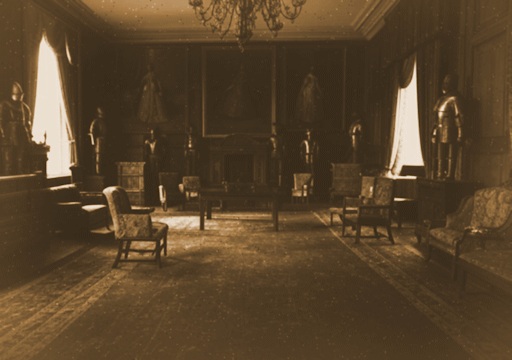 The 15th Earl of Gypping's unique taxidermy collection, circa 1890Taxidermy was extremely popular in the Victorian era, and the 15th Earl of Gypping was a keen practitioner of the craft. During his tenure, he filled room after room in Hemlock Hall with the results of his labours. While most Victorian taxidermists practised their art on animals, Lord Murray was unusual in that he stuffed the remains of his estate workers. Having started with Jenkins the Butler in 1848, stuffing deceased estate workers became a Hemlock Hall tradition - a tradition that endured right up until the 15th Earl's death in 1897. Despite the fact that some of the exhibits are now in less than perfect condition, showing signs of damage caused by mould, damp and rats, the 15th Earl's unique taxidermy collection is a highlight for visitors to modern-day Hemlock Hall. 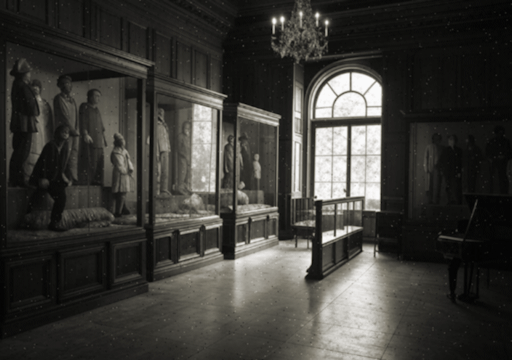 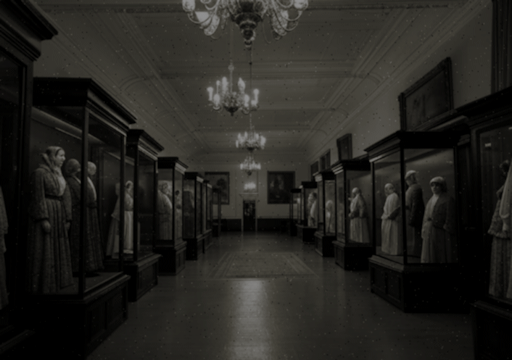 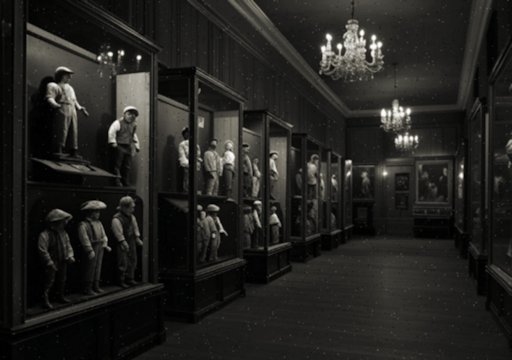 Abigail Morris, Britain's last anchoress, circa 1890This photograph, taken around 1890, shows the brick-built, doorless 'anchorhold' that was the home of Abigail Morris, Britain's last anchoress. Abigail remained in her ten feet square anchorhold from 1853 until her death in 1903, apart from a brief episode in 1878 when she managed to escape for a few days following a crisis of faith. After her death, Abigail was buried beneath the floor and the anchorhold was converted into a shed for the use of the sexton, which can still be seen today. 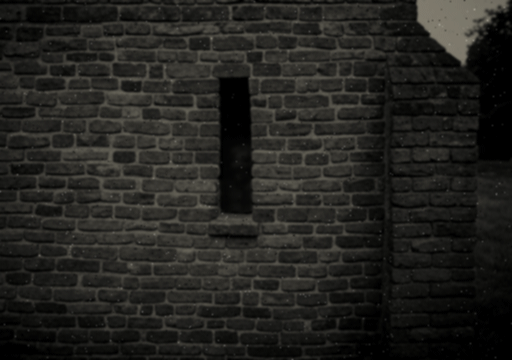 The 15th Earl of Gypping preparing for the Feast Day of Saint Bodkin in 1896This photograph, taken in Saint Bodkin's church in 1896, shows the 15th Earl of Gypping, resplendent in his long, flowing cloak and goat head mask and holding the Sacred Knife of Bodkin, preparing for the ceremony that forms the climax of the day (in more ways than one) on the Feast Day of Saint Bodkin. 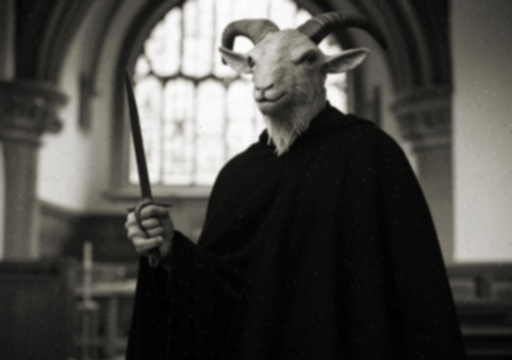 The 16th Earl of Gypping brings electricity to Hemlock Hall, 1899In contrast to his taxidermist father, the 16th Earl of Gypping was fascinated by science and innovation and was always tinkering with one invention or another. In 1899 he brought electricity to Hemlock Hall, making it the first house in the village to have an electricity supply. While other electrical pioneers in English country houses relied on water management schemes or steam power to produce their electricity, Lord Murray preferred to use a more traditional power source for his dynamos. He installed two large wooden treadmills in the cellars of Hemlock Hall and entered into an agreement with Saint Bunty's Orphanage, under the terms of which the orphanage provided the manpower (or, to be more accurate, 'childpower') to power the dynamos 24 hours a day, in return for a small reduction in the orphanage's ground rent. 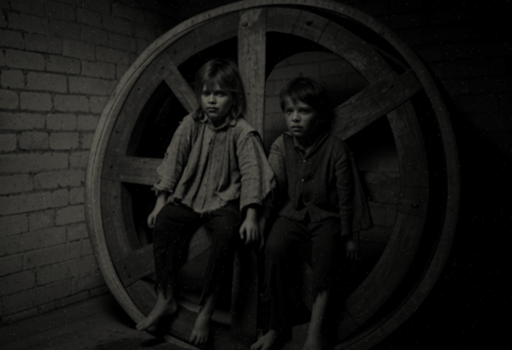 The orphan-powered treadmills proved to be such a cheap and reliable source of power for Hemlock Hall, with only the occasional maiming and fatality being recorded, that they remained in use until 1937, long after mains electricity had been introduced into the village. In that year, Lord Murray calculated that the cost of mains electricity had fallen below the cost of providing the treadmill-pounding orphans with gruel, crutches and coffins, so the treadmills were decommissioned and Hemlock Hall was finally connected to the mains. 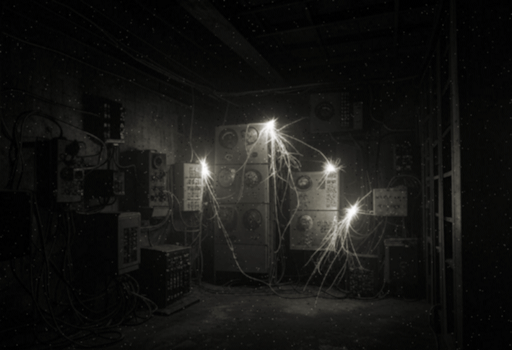 The 16th Earl of Gypping and Lincolnshire's first electric car, 1910Having brought electricity to Hemlock Hall, the 16th Earl of Gypping was keen to investigate whether it would be possible to use the hall's electricity supply to power a car. Many inventors were experimenting with electric cars in the early 1900s, but rather than installing batteries in his electric car as was the norm, Lord Murray chose to power his car using a fixed electric cable. One end of the cable was attached to an electric dynamo in the Hemlock Hall cellars, while the other end was attached to the car. As the car drove along, the cable paid out automatically, via a simple cable reel that was installed on the side of the car. Lord Murray initially discovered that the lights in Hemlock Hall dimmed significantly whenever he took his car out for a test drive. To get around this problem and to ensure that sufficient electricity was being produced to power both the hall and the car, he installed a third orphan-powered treadmill in the cellars of the Hall. Although the car worked well on the whole, the fixed electric cable was its 'Achilles heel': it frequently snagged on obstacles, and pedestrians and horses were prone to tripping over it. On top of this, Lord Murray never completely solved the problem of how to reel the cable back in once it had been fully unwound. As a result of these issues, after six months of experimentation, Lord Murray decommissioned the third treadmill, scrapped the electric car, and turned his attention to a more tried and tested technology: steam power. 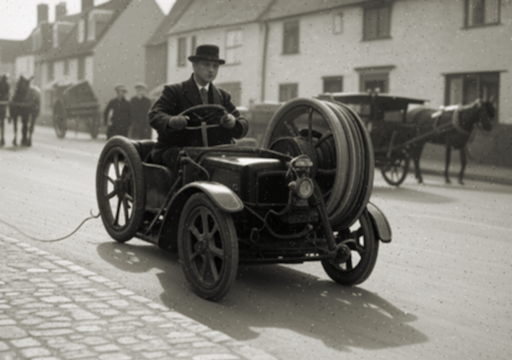 The 16th Earl of Gypping: steam power pioneer, 1912 - 1916Having designed and built Lincolnshire's first electric car, the 16th Earl of Gypping funded the development of one of Britain's first steam-powered cars - the Murray Steamer - which went through several iterations before Lord Murray abandoned the idea. The following series of photographs show prototypes of the Murray Steamer at each stage of its development. Lord Murray had hoped that the Murray Steamer would be a runaway success and that sales of the machine would secure the future of Hemlock Hall, which was in need of expensive repairs to the roof and foundations at the time. However, the only things that ran away whenever Lord Murray drove his temperamental contraptions through the village on experimental runs were the village folk and their horses. The first photograph in the series shows the first Murray Steamer prototype making its way through Gypping in the Marsh in 1912. Lord Murray made several trial runs through the village in the summer of 1912 in this prototype, until a boiler explosion in August of that year resulted in the complete destruction of the vehicle, severe damage to two cottages on Spring Lane and the sad demise of two inhabitants of the cottages. 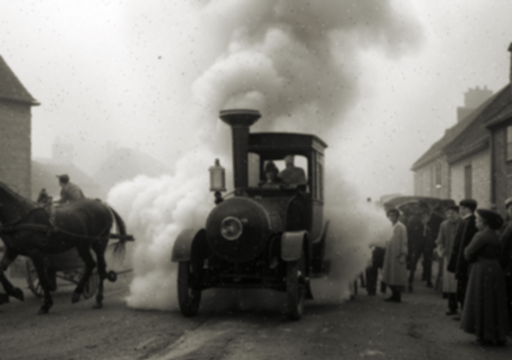 After the loss of the first prototype, Lord Murray went back to the drawing board and came up with the second version of the Murray Steamer, here seen in action in the streets of Gypping in the Marsh in 1913. At the end of the vehicle's second trial run, its boiler exploded in Hemlock Hall's stableyard, resulting in the complete destruction of the west end of the stable block and the unfortunate death of three stable boys. 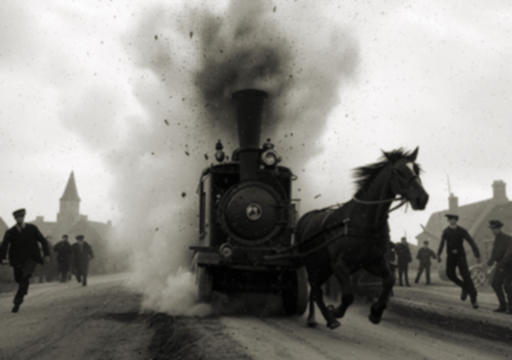 The third photograph in the series shows the final prototype Murray Steamer on its first - and last - run through Gypping in the Marsh in 1914. In this final version of the vehicle, the driver and passengers are placed unusually high above the ground, in an attempt to get them as far away as possible from the temperamental boiler. The photograph captures the precise moment at which the Murray Steamer's boiler exploded. Miraculously, Lord Murray and his butler, who were at the helm at the time, escaped completely unharmed. The same cannot be said of the visiting group of choirboys from Cambridgeshire, who were walking along the road to Saint Bodkin's church at the time of the explosion and were caught in the blast. They lost five of their number. Shrapnel marks, left by the shards of red-hot metal that flew out from the exploding boiler, can still be seen in the stonework of the buildings that face the north side of the village green, as can several fragments of bones and teeth, embedded deep in the walls of the buildings. 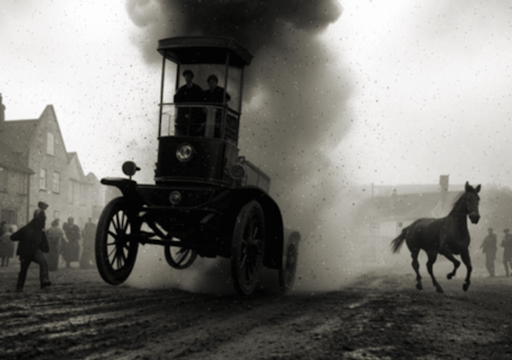 After this final catastrophe, Lord Murray abandoned his attempts to develop a steam-powered road vehicle. He instead turned his attention to harnessing the power of steam on a smaller scale, and developed the world's first - and last - steam-powered alarm clock. The resulting explosion not only devastated the guest bedrooms in the south wing of Hemlock Hall in 1916, but altered the course of succession in the Biskitt family, who were visiting guests of Lord and Lady Murray at the time: the Viscount's eldest son was sadly killed in the blast. Lord Murray subsequently took up stamp-collecting as a hobby. 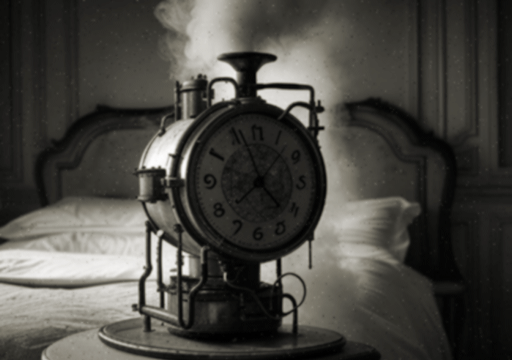 Reverend Murray celebrating the Feast Day of Saint Walstan in 1924This photograph shows the vicar of Gypping in the Marsh, Reverend Murray, celebrating the Feast Day of Saint Walstan in Saint Bodkin's church on Sunday 30th March, 1924. Saint Walstan, who was a patron saint of farm animals, has been venerated in Gypping in the Marsh from time immemorial. On his feast day, the altar of Saint Bodkin's church is gaily decorated with the entrails of cows and bulls and during the church service, the vicar solemnly daubs the forehead of each member of the congregation with blood and gore from the entrails. It is not recorded when or why this tradition - which is unique in the British Isles - started, or why Saint Walstan is so venerated in Gypping in the Marsh; but the present-day vicar and congregation are rightly proud to be maintaining such a long-standing tradition, just as their ancesters did. 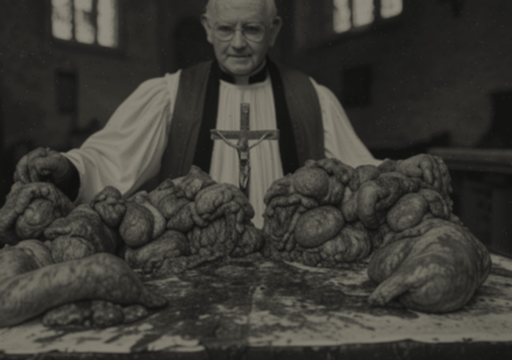 Women collecting snowdrops in the churchyard to be burned, 1927The Victorians believed that bringing snowdrops into the home could bring bad luck; other folklore told of snowdrops turning milk sour and spoiling eggs. In Gypping in the Marsh, beliefs like this have persisted into the present day. In a custom that is unique to the village, locals collect snowdrops from the churchyard as soon as they come into flower, then burn them in a ritual pyre, to ensure a good harvest from the fields later in the year. This photograph from 1927 shows local women collecting snowdrops in the churchyard, ready to be burned. 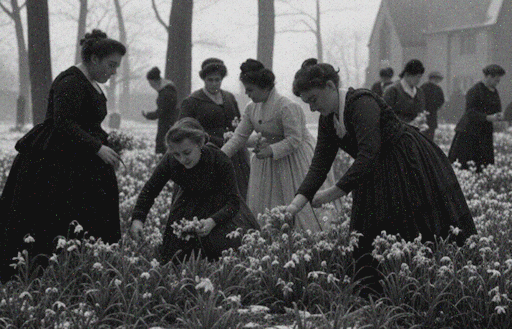 Constable Flanagan on the beat, 1928Constable Flanagan served as the village policeman in Gypping in the Marsh from 1918 until 1929. He was very well-regarded by the villagers, and was a frequent sight as he patrolled the village streets on foot. Constable Flanagan's one peculiarity was his refusal to wear trousers, behaviour that was put down to shell-shock that he suffered having served in Flanders during the first world war. As he was such a well-loved character, the villagers put up with his somewhat unusual attire without comment. Constable Flanagan was unfortunately forced to retire as a result of the severe frostbite that he suffered while on duty during the unusally cold winter of 1928-29. 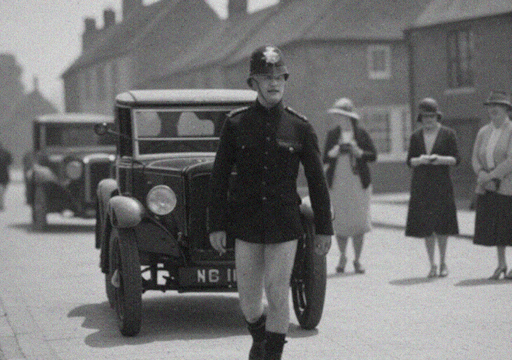 A Murray's Lard Cakes delivery van in the 1930sThis photograph, taken at some point in the 1930s, shows a Murray's Lard Cakes delivery van on the edge of the village. Murray's lard cakes were very popular in the first half of the 20th century, but changing tastes - and a local outbreak of botulism - meant that the business was sadly forced to close in 1954. 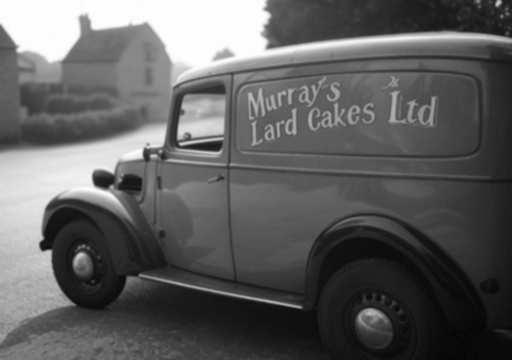 The May Day 1933 recumbent wicker bunnyGypping in the Marsh is famous for its unique 'Wicker Bunny' ceremony which takes place on May Day each year, in which a large wicker effigy of a bunny rabbit is stuffed full of small farm animals and set alight by the lord of the manor in front of the village folk. The wicker bunny is traditionally presented in a sitting position, with its ears pointing skywards. May Day 1933 was notable for its unusual 'recumbent' bunny. This was an experiment that was not to be repeated, as that year's bunny lacked the required structural strength, resulting in a number of animals escaping from the bunny before it was fully ablaze and having to be hunted down with axes, mattocks and fire extinguishers. 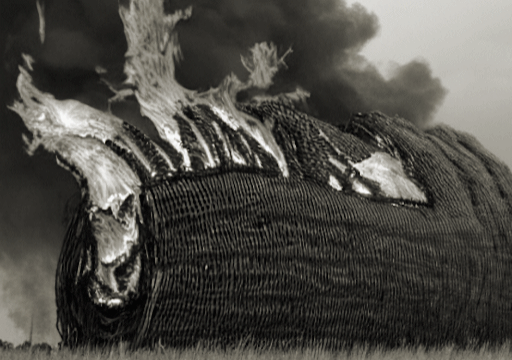 World War 2 bomb damage, November 1940The remoteness of Gypping in the Marsh meant that it almost completely escaped the damage caused by German bombing raids during the second world war. The one exception was Mr Littlejohn's cottage, which was hit by a stray bomb on 14th November 1940 - the night of the infamous Coventry Blitz. This was the only bomb that hit Gypping in the Marsh throughout the entire war. Somewhat ironically, Mr Littlejohn was known to have been a keen supporter of Oswald Moseley's Blackshirts throughout the 1930s, as well as being a regular reader of the Nazi-sympathising Daily Mail. Finding little sympathy for his plight amongst the villagers, Mr Littlejohn left Gypping in the Marsh after the destruction of his cottage, never to return. 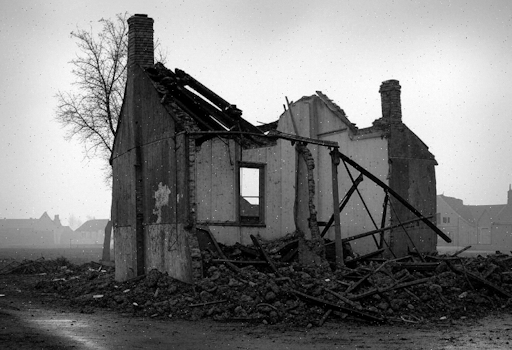 Collecting dead dogs to help the war effort, March 1941During the second world war, communities across the country worked together to collect things such as scrap metal and paper to be recycled, to help the war effort. For some reason, Mrs Ellis of Gypping in the Marsh got it into her head that collecting dead dogs would aid the war effort, and in March 1941 she mobilised the village children to collect as many of them as they could find. Mrs Ellis was quickly disabused of her strange notion when she turned up at the local RAF base with a group of children, pushing prams and carts full of canine corpses. After attempting to initiate a similar human excrement-collecting campaign later that year - and with suspicion growing that she may have helped some of the dogs on their way toward being corpses - Mrs Ellis was admitted to Saint Bodkin's Institute for the Insane, where she remained until her death in 1953. 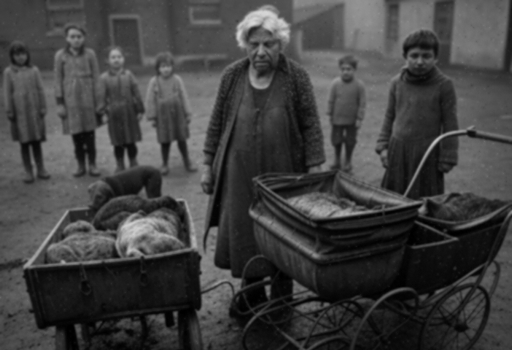 Norbert the chimp in the 1950sGilbert 'Ahab' Murray, a merchant seaman in the 1950s, brought a chimp back with him after a voyage to Africa as a present for his wife, to keep her company while he was away at sea. The creature was apparently completely house-trained and would sit in the lounge, dressed in a sailor's suit, sipping tea quite happily. The chimp - Norbert - was apparently excellent company for Gilbert's wife, Muriel... until the day that it decided to dash her brains out with a toaster. 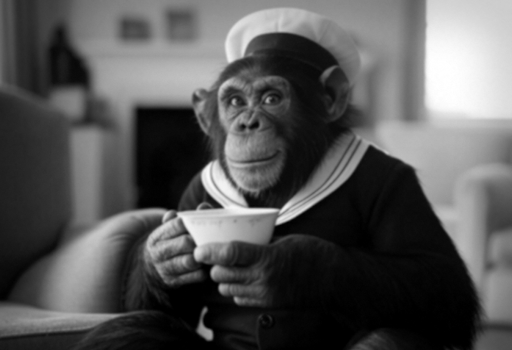 Herr Verrückt's experimental space rocket, 1959Herr Verrückt was a German rocketry scientist who worked on the V2 programme during the second world war. After the war, the British government brought him over to England to help develop rocket engines at an RAF base in Lincolnshire, and he settled in Gypping in the Marsh. Herr Verrückt became fascinated by the US/Soviet space race and in his spare time, he designed and built his own space rocket in his back garden. Inspired by the Soviet rocket that sent Laika the dog into space in 1958, Herr Verrückt told locals that he was planning to send a guinea pig called Lucky into orbit in his own rocket, which he named 'Engel der Rache'. However, when Herr Verrückt launched 'Engel der Rache' on 15th April 1959, it transpired that he had given it a somewhat unexpected trajectory. Rather than heading up into space, the rocket flew straight to London, where it landed in St James's Park, just short of Buckingham Palace, leaving a massive crater but thankfully causing no serious injuries. Herr Verrückt was arrested later that day and charged with animal cruelty offences. Sadly, Lucky the guinea pig did not live up to his name. 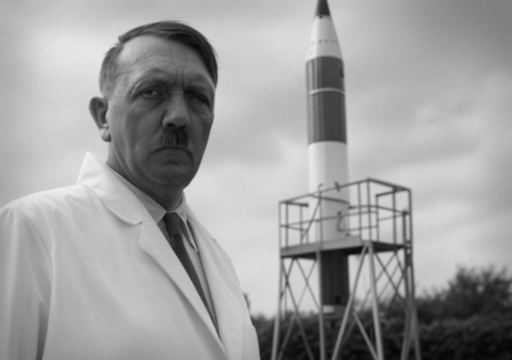 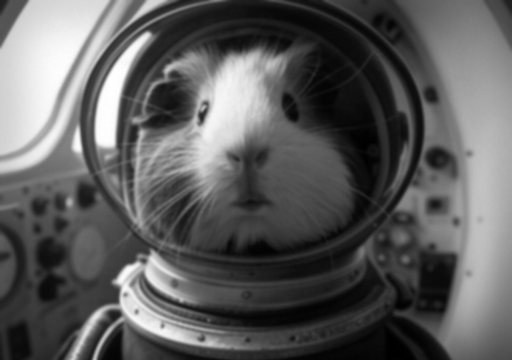 A Gypping Drinks delivery lorry in the 1960sDoes anyone remember Mr Gadd, who used to travel around south Lincolnshire in the Gypping Drinks lorry in the 1960s and early 1970s, delivering soft drinks door to door? His happy, smiling face was a regular sight in Gypping in the Marsh, until a few of the locals discovered him doing something unspeakable with the bottles in 1974. After this, he was never seen in the village - or anywhere else, for that matter - again. 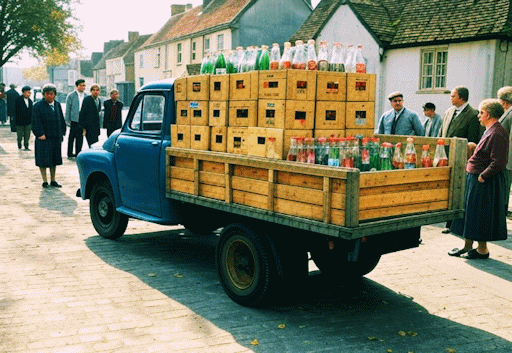 Five character studies by Newton Applethorpe, early 1970sThe following photographs are taken from a series called 'Fenland Lives', taken by the renowned Gypping in the Marsh photographer Newton Applethorpe (1946-1989). In this series, Applethorpe aimed to capture the essential essence of everyday people working in the fenland country. Five of the photographs - the ones you see below - were taken in Gypping in the Marsh in 1971 or 1972. The first shows Mr Murray, the village butcher, in the back room of his shop. Despite the passage of time, the back room of the village butcher's shop has not changed a great deal since this photograph was taken. Sadly, Mr Murray took his own life in 1974, following an unsatisfactory inspection by officers from the local Environmental Health department. 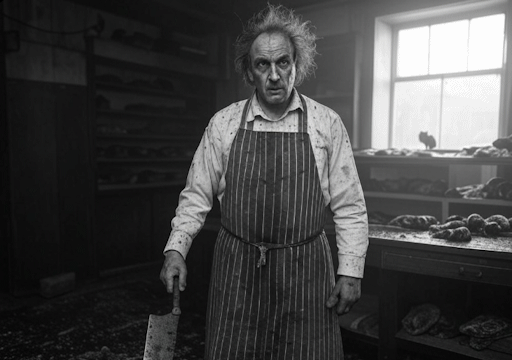 The second photograph shows Mrs Murray, the village baker, whose bubbly personality and cheery countenance brought joy to the villagers for many years. The Murray family have owned the village bakery for generations; the sign above the door boasts that 'We've been in bread for over two hundred years'. 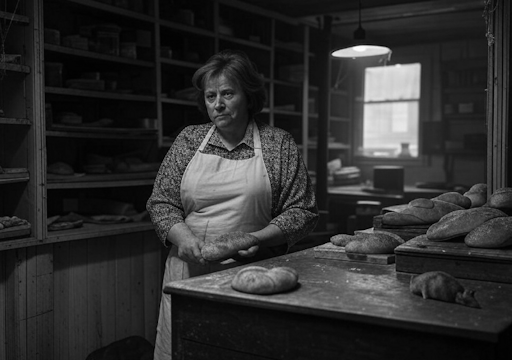 The third photograph in the series depicts Mr Bateman, the owner of Gypping General Stores. Of the four business premises depicted in this series of photographs, this one has changed the most since the photographs were taken, thanks to the introduction of self-scanning tills and the preponderance of vaping equipment that now graces the shelves. Mr Bateman was renowned for his muscular 'zero tolerance' approach towards shoplifting. He ran Gypping General Stores from 1966 until 1977, when he took early retirement after the unfortunate death of a local schoolboy whom he alleged had walked out of the shop without paying for a packet of mints. 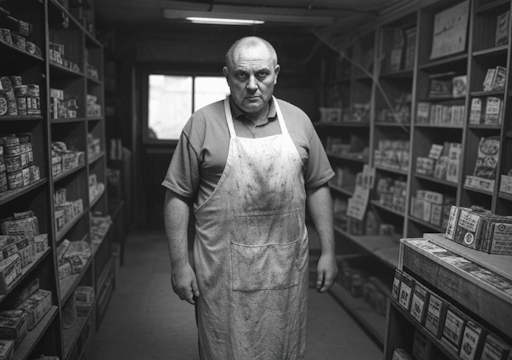 The fourth photograph in the series depicts Mr Dexter, the owner of the Morris Motors car dealership in Gypping in the Marsh. Mr Dexter was a very successful car salesman throughout the 1960s and early 1970s, and most of the villagers drove Morris cars during this period as a result. Mr Dexter's car dealership closed down in 1977, after a growing number of young, female Morris drivers in the area going missing prompted police to search the premises. During the search, the police found that used engine oil was not the only thing that Mr Dexter kept in the oil drums in his garage. The garage later re-opened, under new ownership, as a Lada dealer.  The final photograph in the series depicts Mr West, the Gypping in the Marsh scout master in the early 1970s, who used to run regular scout camps on Gypping Marsh. Mr West was a very popular figure around the village until the day in 1974 when he disappeared, along with two of the boy scouts from his group. The three were not found until 13 years later, when police discovered them living together 'off-grid' in a remote valley in mid-Wales. 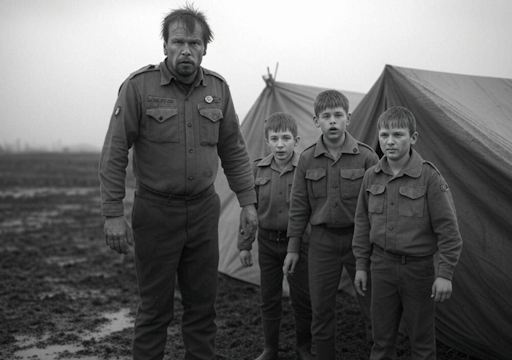 Mr Cartman and the 'Gypping Marsh UFO', 18th September 1975This blurry photograph of what became known as the 'Gypping Marsh UFO' caused a sensation back in September 1975. Supposedly snapped by a local man - Mr Cartman - who was out walking his dog on Gypping Marsh in the early evening, debate raged over what exactly the photograph showed. Was it an alien spacecraft? Was it an experimental aircraft from a nearby airbase? Was it a frisbee? Was it for real, or was the whole thing a hoax? Regardless of the truth of the matter, the story made its way into the national newspapers and Gypping in the Marsh became a magnet for UFO enthusiasts for months afterwards. 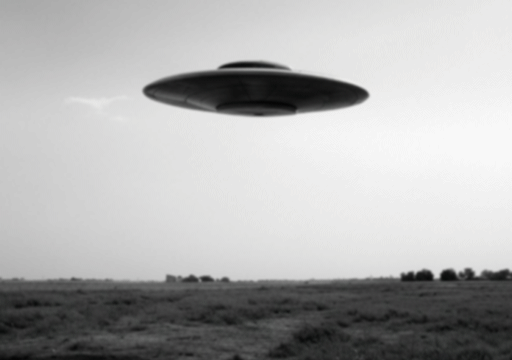 Mr Cartman always maintained that the photograph was genuine. Initially, he claimed to have 'lost' three hours on the evening on which the photograph was taken. As time went by, his claims became ever more outlandish. By 1977, he was claiming that he had been 'probed internally' by aliens and that as a result he could receive BBC World Service radio directly in his head. He started wearing a helmet made out of tinfoil at all times 'to block the alien transmissions'. Having repeatedly warned anyone who would listen that the aliens would come back for him one day, Mr Cartman disappeared one night in 1978 and was never seen again. Did the aliens return and take him away? Or had he merely 'buggered off to Great Yarmouth to shack up with his fancy woman', as his wife maintained? This is one mystery that has never been solved. 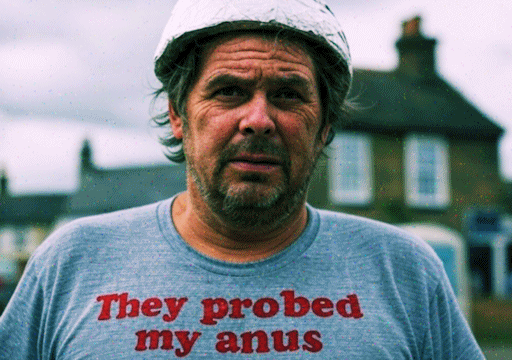 'Raving Gerald' and his sandwich board, 1983'Raving Gerald', as he was affectionately known in Gypping in the Marsh, could often be seen walking around the village in the early 1980s with his sandwich board, loudly preaching hellfire and damnation to anyone who would listen. His warnings that 'the end is nigh' turned out to be strangely prophetic - for Gerald, at least - as he was run over and killed by a Lincolnshire RoadCar double-decker bus in the centre of the village in January 1984. 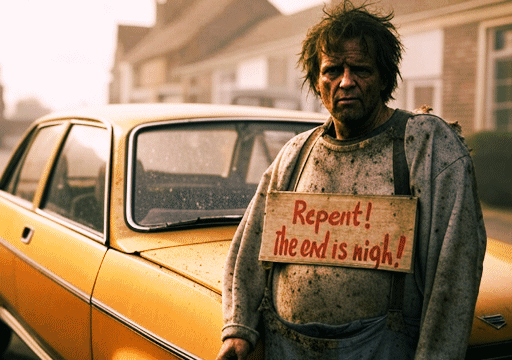 The opening of the Jimmy Savile Infirmary Wing, Saint Bunty's, 1991The famous Radio 1 DJ, Jimmy Savile, had been a generous benefactor to Saint Bunty's Home for Parentally-Challenged Children for many years before the decision was taken by the orphanage to name their new infirmary wing after him. Savile donated so much money to Saint Bunty's over the years that the orphanage allowed him to stay there, free of charge, whenever he was travelling in the area, giving him keys to the building to enable him to come and go as he pleased. Savile made use of this privilege often, staying in a small bedroom next to the girls' dormitory that had been set aside for his personal use. No doubt his frequent visits gave the children experiences that would stay with them for the rest of their lives. This photograph shows Savile at the opening of the new Jimmy Savile Infirmary Wing in October 1991, celebrating with three of the orphans. 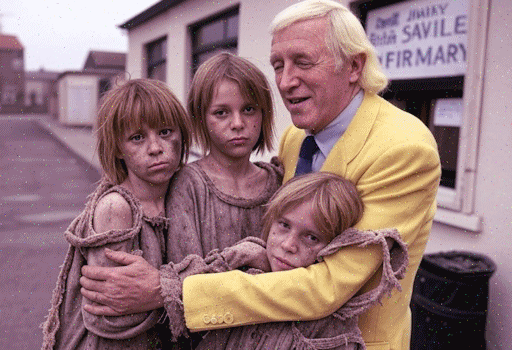 The village scout hut destroyed by a bomb, 14th October 2000Wing Commander Gilbert Murray, DSO, CBE, SOB (rtd.), organised a fly-past by the RAF Battle of Britain Memorial Flight on 14th October 2000, to commemorate the 60th anniversary of a famous dogfight that took place in the skies above the village during the second world war - the Battle of Gypping Marsh. The entire village turned out to watch an Avro Lancaster bomber, accompanied by a Supermarine Spitfire and a Hawker Hurricane, as they flew low in formation over the village. Unfortunately, the day was marred by two regrettable events: firstly, by an unfortunate mix up involving a case of live shells that had been marked 'blanks', which resulted in the cheering villagers being strafed as the aeroplanes flew low along the High Street; and secondly, by Wing Commander Murray's accidental bombing of the village scout hut. Wing Commander Murray's lawyer, Welsby, subsequently managed to get all charges against him dropped, and persuaded the judge to award him costs against the bereaved families. 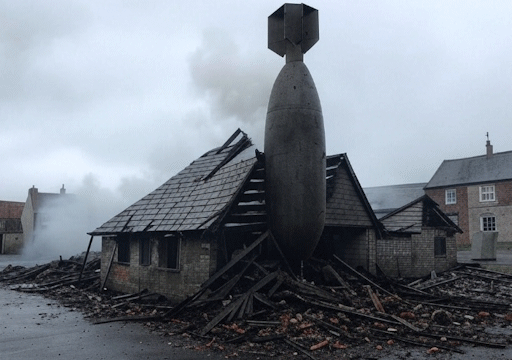 'Brexit Day' celebrations, 31st January 2020The Europhobic residents of the village - 'Mad Roger' and his dog - came out in force on 31st January 2020 to celebrate 'Brexit Day', when at 11pm GMT, the United Kingdom officially left the European Union. The lively celebrations started in the afternoon and went on well into the night, until annoyed villagers insisted that Roger shut up and go home to bed. 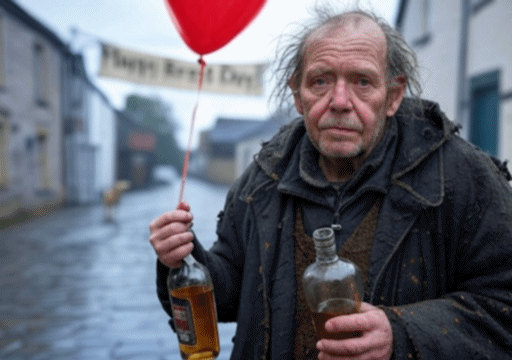 Copyright 2003-2025 www.gilbertmurray.co.uk. All rights reserved. |